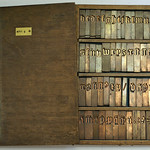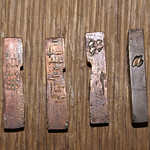The characters that make up the scripts used around the world are inventions of humanity. The differences between these scripts and their underlying structures make it likely that the requirements are often culturally and historically based. You cannot apply the same (design) rules regarding harmony and rhythm for the Latin script to, for example, Hangul, just as the traditional music of Korea is not comparable to Western music and even seems to lack what we call harmony.

Part of a Korean newspaper that combines roman type with Hangul
Therefore, the rules of typography are derived from the scripts, that is, the letterforms themselves. Rules such as the ‘hierarchy of space’ (the relationship between the space in the counters, the space between the letters, between the words, between the lines, and the size of the margins) cannot be universal, i.e., ‘cross-scripts’ applied, but only within the (elements of the) scripts themselves. These rules are anchored in what I would call grapheme systems (see Systems and Models).
The grapheme systems are the result of the sum of evolution, direct interference by scientists and (the moments in time of) technical innovations. They are neither perfect nor sacred, but anchored in convention. Conventions are blueprints for conditioning and conditioning in turn maintains the conventions. That may be a scary thought for those who teach type design (at least it is for me!), but we just have to recognize this fact and deal with it.
To meet or deviate from the requirements, it is necessary to understand the structure of the underlying systems and models. The themes on which all current type designers make variations have their origins in systems and models that emerged in the fifteenth century with the invention of movable type. Type designers actually apply a relatively thin (but often complex) veneer by creating variations on the more than five age-old themes that have become the standard. The newly created fonts are the result of the designers' insight, technical skill and, of course, the spirit of the times.
Letterforms created for Latin but falling outside its conventions, such as Wim Crouwel’s New Alphabet, can only be judged as such by applying the rules arising from the underlying structure, that is, conventions defined by this type design itself.




